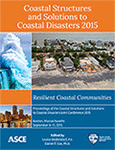Coastal Structures and Solutions to Coastal Disasters Joint Conference 2015
A Review of the Methods Used to Improve the Resilience of Communities in Low-Income Countries to Coastal Floods and Their Relevance to the U.S.A.
Publication: Coastal Structures and Solutions to Coastal Disasters 2015: Resilient Coastal Communities
ABSTRACT
Coastal communities in low-income countries are often very vulnerable to storm surges. Many low-income countries have achieved considerable success in increasing the resilience of their populations to coastal flooding and tropical cyclones. For example, the Bangladesh Cyclone Preparedness Programme has successfully warned, evacuated and sheltered millions of people from cyclones since its inception in the early 1970s, reducing loss of life from extreme cyclonic events by several orders of magnitude. Cuba is affected by hurricanes that often hit the U.S.A. However, when normalized the number of deaths caused by recent hurricanes is 20 times lower in Cuba than it is in the U.S.A. This paper briefly examines how Bangladesh and Cuba, have increased their social resilience to coastal flooding and whether the lessons learnt are transferable to disadvantaged coastal communities in the U.S.A. in order to assist them in improving their own resilience to hurricanes and coastal flooding.
Get full access to this article
View all available purchase options and get full access to this chapter.
REFERENCES
Adger, W. N. (2000). Social and ecological resilience: Are they related? Progress in human geography, 24, 347-364.
Cash, R.A. Shantana R Halder, Mushtuq Husain, Md Sirajul Islam, Fuad H Mallick, Maria A May, Mahmudur Rahman, M Aminur Rahman (2013). Reducing the health effect of natural hazards in Bangladesh
Cutter, S.L., Johnson, L.A., Finch, C. and Berry, M. (2007). The U.S. hurricane coasts: Increasingly vulnerable? Environment, science and policy for sustainable development, September 2007, published by Taylor and Francis
Garschagen, M., Hilft, P., Misereor, A., Seibert, T., Welle, T., Birkmann, J., Rhyner, J., Kholer, S., Loster, T., Reinhard, D. and Matuschke, I. (2014). World risk report 2014 published by Bündnis Entwicklung Hilft (Alliance Development Works) and United Nations University – Institute for Environment and Human Security (UNU-EHS), ISBN 978-3-9814495-4-9
Majumder, S. (2013) The economics of early response and resilience: Bangladesh country study, Available at: https://www.gov.uk/government/uploads/system/uploads/attachment_data/file/228494/TEERR_Bangladesh_Background_Report.pdf.
Miah, M. D., Kabir, M. H., Koike, M. and Akther, S. (2011). Major climate-change issues covered by the daily newspapers of Bangladesh. Environmentalist, 31, 67-73.
Mitchell, A. (2013). Risk and resilience: From good idea to good practice. OECD, France.
Neumann, B, Vafeidis, A T, Zimmerman, J and Nicholls, R. J. (2015) Future coastal population growth and exposure to sea-level rise and coastal flooding - a global assessment. PLoS ONE, 10, (3), e0118571.
Newhouse, E. (2011) More lessons from Cuba’s hurricane preparedness and civil defense, Centre for International Policy Delegation Report, December 2011 Available at: http://www.ciponline.org/images/uploads/publications/1111_Delegation_ReportCuba.pdf
Ovacool, B. K., D'Agostino, A. L., Rawlani, A. and Meenawat, H. (2012). Improving climate change adaptation in least developed Asia. Environmental Science & Policy, 21, 112-125.
Oxfam America (2009). “Exposed: Social vulnerability and climate change in the US South-East”.
Paul, B.K. (2010). Human injuries caused by Bangladesh’s cyclone Sidr: An empirical study. Natural Hazards 54, pp483-495.
Pichler, A., and Striessnig, E. (2013). Differential vulnerability to hurricanes in Cuba, Haiti, and the Dominican Republic: The contribution of education. Ecology and Society 18(3): 31
Ready Georgia (2015) GEMA urges Georgians to get ready for hurricane season Hurricane Preparedness Week educates residents about actions to reduce the effects of disastrous storms. http://ready.ga.gov/pressrelease/gema-urges-georgians-to-get-ready-for-hurricane-season/
Ruhul Amin, M. (2012) Motivating volunteers: A case of cyclone preparedness programme volunteers in Bangladesh. A dissertation for the degree of master in disaster management
Sims, H. and Vogelmann, K. (2002). Popular mobilization and disaster management in Cuba. Public Administration and Development, 22, 389-400.
Spanger-Siegfried, E., Fitzpatrick, M.F. and Dahl, K. (2014). “Encroaching tides: How sea level rise and tidal flooding threaten U.S. East and Gulf coast communities over the next 30 years”. Cambridge, MA: Union of Concerned
Tompkins, E. L. and Adger, W. (2004). Does adaptive management of natural resources enhance resilience to climate change? Ecology and society, 9, 10.
Information & Authors
Information
Published In
Coastal Structures and Solutions to Coastal Disasters 2015: Resilient Coastal Communities
Pages: 529 - 534
Editors: Louise Wallendorf, U.S. Naval Academy and Daniel T. Cox, Ph.D., Oregon State University
ISBN (Online): 978-0-7844-8030-4
Copyright
© 2017 American Society of Civil Engineers.
History
Published online: Jul 11, 2017
Published in print: Jul 11, 2017
Authors
Metrics & Citations
Metrics
Citations
Download citation
If you have the appropriate software installed, you can download article citation data to the citation manager of your choice. Simply select your manager software from the list below and click Download.
